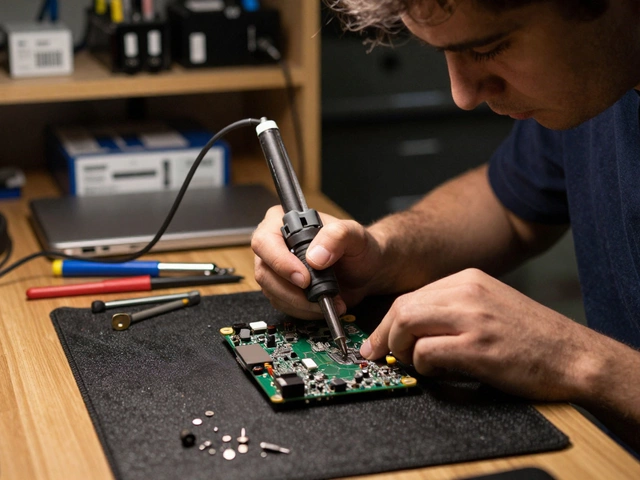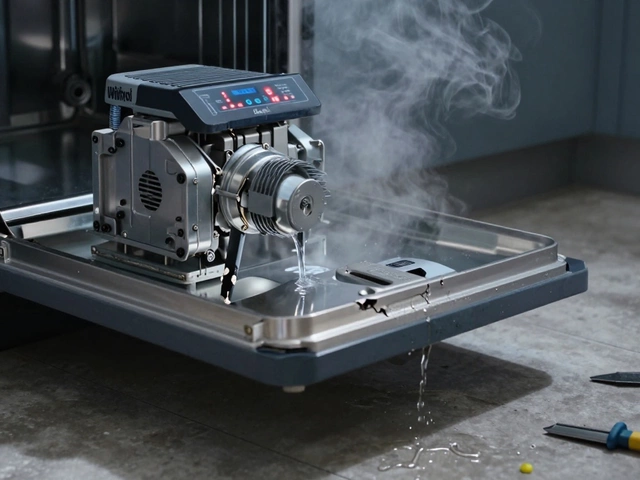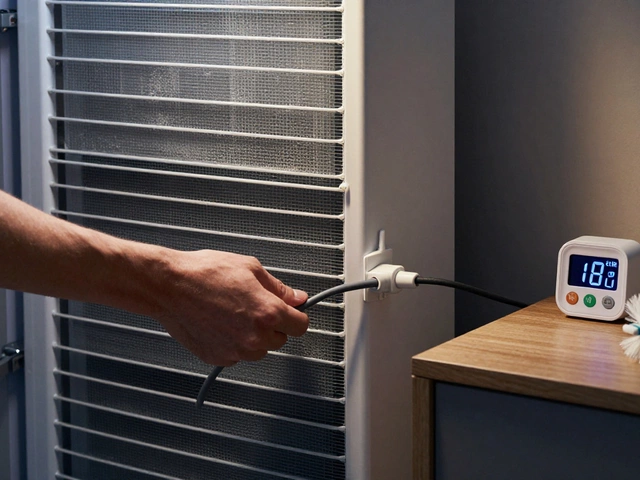Electric Oven Troubleshooting Guide
What's happening with your oven?
Select symptoms to get personalized troubleshooting steps and solutions.
If your electric oven suddenly stopped working, you’re not alone. It’s one of the most common appliance emergencies - especially in Vancouver winters when you’re counting on it to roast a chicken or bake cookies after a long day. The good news? Most of the time, it’s not a total loss. You don’t need to replace the whole thing right away. Here’s what’s likely going on, and how to check it yourself before calling a technician.
Check the power first - it’s simpler than you think
- Look at your circuit breaker panel. Find the breaker labeled oven, kitchen, or range. If it’s flipped to the middle or off position, reset it.
- Some electric ovens use a double-pole 240-volt breaker. That means two switches must both be on. If one is off, the oven won’t heat - even if the lights and clock still work.
- Plug in another high-wattage appliance, like a toaster or kettle, into the same outlet (if your oven is plug-in). If it doesn’t work, the outlet might be dead. If it does, the problem is likely the oven itself.
Many people assume the oven is broken because it won’t heat. But if the display is on and the timer works, you’re probably just missing the 240-volt power needed for the heating elements. That’s a breaker issue, not an oven failure.
The heating element is the most common culprit
Your electric oven has at least two heating elements: one on the bottom for baking, and one on the top for broiling. If one fails, the oven might still turn on - but it won’t get hot enough, or at all.
To check:
- Turn off the power at the breaker.
- Open the oven door and look at the bottom element. It should look like a thick coil. If you see black spots, cracks, or sections that are separated, it’s burned out.
- For the top element, you might need to remove the back panel inside the oven cavity. Look for the same signs: breaks, bulges, or discoloration.
- If you’re unsure, use a multimeter to test for continuity. Set it to ohms (Ω). Touch one probe to each terminal on the element. If it reads infinite resistance or no reading at all, the element is dead.
Replacement elements cost between $30 and $80, depending on your oven model. They’re usually easy to swap - just disconnect the wires, unscrew the mounting brackets, and install the new one. You can find exact replacements by searching your oven’s model number online.
Thermostat or temperature sensor failure
Even if the heating element works, your oven might not reach the right temperature - or it might shut off early. That’s often the thermostat or temperature sensor.
The temperature sensor is a thin metal probe, usually near the back wall of the oven. It tells the control board what the internal temperature is. If it’s faulty, the oven thinks it’s hotter than it really is and shuts off the heat to "protect" itself.
Signs of a bad sensor:
- Oven takes forever to heat up
- Food cooks unevenly or burns on one side
- Error codes like "F3" or "E1" appear on the display
To test: Unplug the oven or turn off the breaker. Remove the sensor (it’s usually held by two screws). Use a multimeter to measure resistance. At room temperature (around 20°C), it should read between 1,000 and 1,100 ohms. If it’s way higher or shows no reading, replace it. Sensors cost $25 to $50.

Control board problems - the brain of the oven
If the breaker’s fine, the elements are good, and the sensor reads correctly, the control board might be the issue. This is the circuit board behind the control panel that sends power to everything.
Signs of a failing control board:
- Nothing turns on - no display, no lights, no beeps
- Buttons don’t respond or respond randomly
- The oven turns on by itself or shuts off unexpectedly
Control boards are harder to diagnose because they don’t always show visible damage. You can’t test them with a multimeter like you can with elements or sensors. If you’ve ruled out everything else, and the oven is older than 8 years, the board is a likely suspect.
Replacing a control board costs $150 to $300, plus labor. For older ovens, it’s often cheaper to replace the whole unit. But if your oven is under warranty or you love its features, replacing the board can extend its life.
Thermal fuse - the safety switch that blew
Every electric oven has a thermal fuse. It’s a small, one-time-use safety device that cuts power if the oven overheats. If your oven stopped working suddenly after a self-clean cycle or if the vent was blocked, this fuse might have blown.
Location: Usually near the broil element or on the back wall of the oven. It looks like a tiny white or black cylinder with two wires attached.
How to check: Turn off power. Remove the fuse and test it with a multimeter. If there’s no continuity, the fuse is blown. You can’t reset it - you have to replace it. Fuses cost $10 to $20.
Important: If the fuse blew, figure out why. Was the oven overheating? Is the vent clogged? Is the cooling fan broken? If you just replace the fuse without fixing the root cause, it will blow again.

Door switch or latch issues
Some ovens won’t turn on unless the door is fully closed. A faulty door switch can trick the oven into thinking the door is open - even when it’s shut.
Signs: The oven light turns on, but nothing else works. Or the oven turns off when you close the door.
Test: Open and close the door slowly while listening for a soft click. If you don’t hear it, or if the oven doesn’t respond, the switch is likely bad. Replacement switches are cheap ($15-$30) and easy to swap.
When to call a professional
You can handle most of these fixes yourself if you’re comfortable with basic tools and safety precautions. But call a technician if:
- You smell burning plastic or see smoke
- Wires are frayed, melted, or exposed
- You’re not sure how to safely disconnect power
- The oven is still under warranty - DIY repairs can void it
- You’ve tried all the above and nothing works
Professional repairs usually cost $100 to $250, depending on the issue and your location. In Vancouver, many local appliance repair shops offer same-day service for oven issues.
Prevent future problems
To avoid another sudden failure:
- Clean your oven regularly - built-up grease can overheat components
- Don’t use the self-clean feature more than twice a year - it stresses the heating elements and thermal fuse
- Keep the oven vent clear - make sure nothing’s blocking airflow behind or around the unit
- Check your circuit breaker every few months, especially after storms or power surges
- Replace worn-out parts early - a cracked element doesn’t need to fail completely before you fix it
Electric ovens are built to last 10-15 years. With a little attention, yours can make it to the end of that range - no expensive replacement needed.
Why is my electric oven display working but not heating?
If the display, clock, or lights work but the oven doesn’t heat, the issue is usually with the 240-volt power supply. Check your circuit breaker - one side may have tripped. It could also be a failed heating element, thermal fuse, or temperature sensor. The control board might not be sending power to the heating circuits, even though it still powers the display.
Can a power surge damage my electric oven?
Yes. A power surge can fry the control board, thermal fuse, or electronic components. If your oven stopped working right after a storm or a flicker in the lights, a surge is likely the cause. Consider installing a surge protector for major appliances - they cost under $50 and can save you hundreds in repairs.
How do I find my oven’s model number?
Look inside the oven door frame, on the side wall, or on the back panel. It’s usually printed on a sticker near the hinge or along the top edge. Common locations include the left or right side of the oven cavity when you open the door. The model number helps you order the exact replacement part - don’t guess.
Is it worth repairing an old electric oven?
If your oven is less than 8 years old and the repair costs less than half the price of a new one, it’s usually worth fixing. For older models, especially if you’re dealing with multiple issues (like a failing control board and worn elements), replacement is often more cost-effective. New ovens are more energy-efficient and come with better safety features.
Why does my oven turn off after 10 minutes?
This usually means the oven is overheating. The thermal fuse or temperature sensor may be faulty, or the cooling fan isn’t working. Check that the vent isn’t blocked and the fan spins freely. If the sensor reads incorrectly, the control board thinks the oven is too hot and shuts it down to prevent damage.




